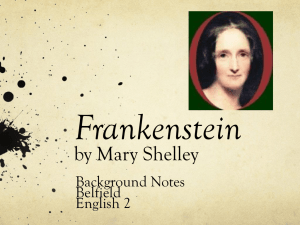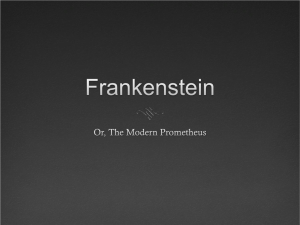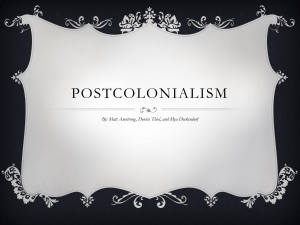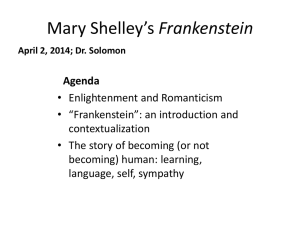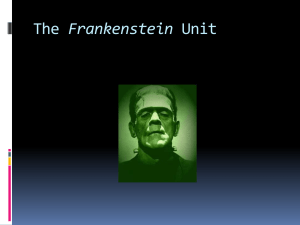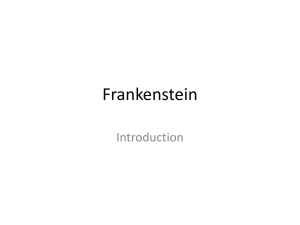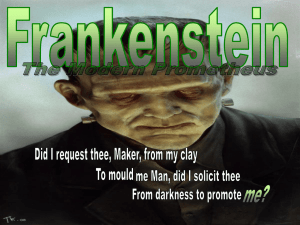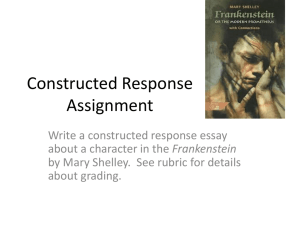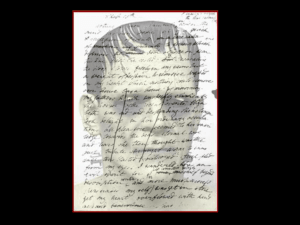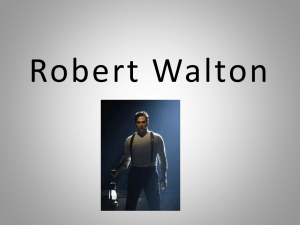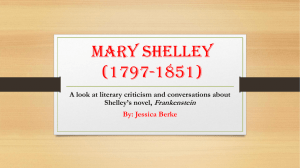Mary Shelley*s Frankenstein - Year 12 Literature
advertisement
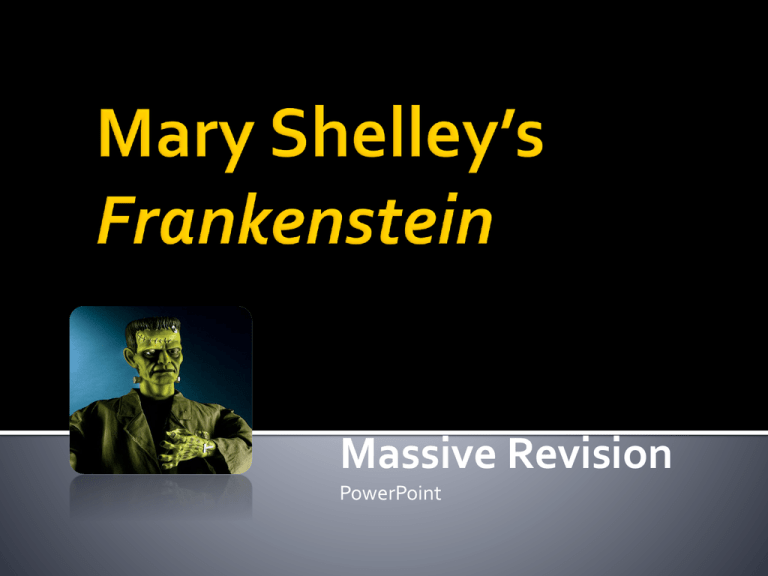
Massive Revision PowerPoint In her novel, Mary Shelley is silent on just how Victor Frankenstein breathes life into his creation, saying only that success crowned "days and nights of incredible labor and fatigue;" Frankenstein offers no monster-making recipes. But Shelley's story did not arise from the void. Scientists and physicians of her time, tantalized by the elusive boundary between life and death, probed it through experiments with lower organisms, human anatomical studies, attempts to resuscitate drowning victims, and experiments using electricity to restore life to the recently dead. Subtitle: The Modern Prometheus Prometheus was one of the Titans Prometheus = ‘forethought’ As a reward for being the only Titan to not rebel against him, Zeus assigned Prometheus the task of forming man Prometheus became fond of his creation: he stole the secret of fire from Zeus and deprived humans of their knowledge of the future, giving them hope instead Prometheus is often seen as a benefactor of human kind In response to his betrayal, Zeus chained Prometheus to a rock where a vulture (or an eagle) pecked out his liver (or heart), which regenerated itself each night so that the punishment was eternal Early in the 18th century, Prometheus had become an accepted image of the creative artist Shelley created a radical shift by transferring the metaphor of Prometheus as artist to Prometheus as scientist. By creating her ‘modern Prometheus’ as a scientist, Shelley is suggesting science is creative Paradise Lost is Milton’s account of ‘Genesis’ Frankenstein – attempting to take on the role of God; defies God in a similar way to Satan; punished for his defiance in a similar way to Satan Where is Eve? – the monster wants Frankenstein (God) to create Eve but he refuses The monster’s narrative parallels the story of Eve The description of Victor and Elizabeth’s childhood is like the innocence of the Garden of Eden The monster’s awakening is a parody of it – beautiful but harsh is the world that he finds. The three concentric layers of the text are presented in three volumes: The text has been described as a ‘Chinese Box’ Captain Robert Walton’s letters home to his sister bookend the story The narrative related by Victor Frankenstein The monster’s story Walton’s story of his voyage to the Pole is a buffer for the reader confronting the more marvellous story of Frankenstein Parallel situation between Walton and Frankenstein – each has a solitary nature, feels largely self-educated, is obsessed with their ‘quest’ and ‘suffers’ from hubris Frankenstein’s narrative warns Walton of the price payable for egocentric obsessions This communicates a number of views and values Plays with the idea that man is essentially good – the creature is like Satan, the fallen angel His passionate responses to nature are typically Romantic Isolation and loneliness are no good (much like when Frankenstein isolates himself with his science) Literature has much to teach us about the world This occurs when the story is told from a number of different perspectives – who all view the same events differently. We have three narrators – but also letters and so on from other characters Victor seeks knowledge for his own reasons Does not consider the ramifications (Very Romantic view of the age) Walton also does this Victor focused on Alchemy before going to university and learning about new science Rime of the Ancient Mariner links in to this, as it suggests the violation/disrespect of nature is a sin. Romantics favoured a ‘natural’ education through reading, rather than a formal one, with adventures providing self-growth. (Critique?) Walton self educated “my education was neglected, yet I was passionately fond of reading.” The creature learns from the DeLacey’s Typical Romantic reading list No- one to guide him in his learning Shelley loses her mother early Elizabeth’s mother died early during childbirth Victor does not care for the creature he ‘parented’ Victor is the real monster – he neglects his own ‘child’ Critiques the cult of the individual, of solitariness and introversion of the time The Gothic novel (mid 18th – mid 19th) – distinctive for its fascination with the horrible, the repellent, the grotesque and the supernatural, in combination with many of the characteristics of the Romantic novel Gothic: emphasis on emotion Gothic art and architecture was intended to have a magical or preternatural effect on the viewer The Gothic building was the perfect setting for a story intended to terrify or otherwise overwhelm the reader Dangerous natural settings were employed (the sublime) Characterised by a chronic sense of apprehension and the premonition of impending but unidentified disaster The Gothic world is the fallen world, the vision of fallen man, living in fear and alienation, haunted by images of his mythic expulsion, by its repercussions and by an awareness of his unavoidable wretchedness Action tends to take place at night or in a claustrophobic, sunless environment Some motifs of typical Gothic fiction include: images of death; revenge; family curse; the Doppelganger; demonic possession; masking/shape changing; madness Coleridge, Byron and Percy Bysshe Shelley were all steeped in this tradition Psychologically, the Gothic novel is generally understood to serve a fundamental human need: Can be called ‘the strange human need for feeling afraid’ The need to retain links to the past Frankenstein centred around: Thirst for knowledge A scientific over-reacher Forbidden knowledge and the mysteries of life The emphasis in Frankenstein is on psychological terror The scientific experiment can be seen as proving that the masculinist arts of civilisation can only reanimate the dead and deaden the living. It is the feminine and naturing aspect of reproduction that would have saved the creature from his lonely life. Preference for grandeur, the picturesque, the sublime, passion and extraordinary beauty as opposed to finish and proportion (i.e. rugged landscape). The creature is moved by the power of the natural world, and Frankenstein escapes to nature to think. Walton seeks to subjugate it. The natural world reflects the danger and trauma of the emotional worlds of the characters. Explored the emotional directness of personal experience: Extremes of rapture, nostalgia (for childhood or the past), horror, melancholy or sentimentality Cultivation of the exotic, the bizarre or the macabre Interest in the irrational realms of dream and delirium Frankenstein as a Romantic novel The growth of the individual mind is enabled through knowledge of, and closeness to, nature and not from man A moral fable on the self-destructive consequences of idealism and solitary obsession in a quest for passionately knowing Self-consciousness in the Romantic period is only a state which must be passed through so that it may be transcended Frankenstein’s creature moves through the layers of self- awareness to develop into the ‘modern man’ However, while he finds his own self, he does not develop into the next ‘stage’ – he stays ego-centric and unable to truly understand what is beyond himself, his own passions and his own need for vengeance Are we to recognise that knowledge needs to be dispensed simultaneously with moral instruction? (perhaps this is the feminine again?) Shelley’s protagonist is so completely engrossed in his own ego that he must create a being to reassure himself of his own existence: Frankenstein’s consciousness alienates him from life, causing him to become a solitary figure He creates another being, who stands as a double (doppelganger) or subconscious element of himself This grotesque usurpation of women’s bodies essentially deepens his own crisis of self-consciousness, for, in embodying his alter-ego he cannot now go beyond it and return to a state of former innocence There is the sense of the Doppelganger in Frankenstein’s creature Frankenstein’s monster is a magnified image of the self of the creator, indicative of Victor’s profound narcissism This monster represents a larger than life superego of his creator (remember its size) Frankenstein concedes that the monster he created is in essence a part of his spirit, his mirror: “my own vampire, my own spirit let loose from the grave, and forced to destroy all that was dear to me” Frankenstein becomes the epitome of egotism and selfconsciousness: To Walton, Frankenstein confessed that his “eyes [became] insensible to the charms of nature. And the same feelings … caused me also to forget those friends who were so many miles absent” The wounded deer Frankenstein comes across in the Alpine valley he sees as ‘a type of me’ Frankenstein was so self-obsessed that he cannot consider the possibility that it may be Elizabeth who dies at the hand of the monster on their wedding night When he does consider the scenario of his own death he is self-gratifyingly morbid: “yet when I thought of my beloved Elizabeth – of her tears and endless sorrow, when she would find her lover so barbarously snatched from her – tears, the first I had shed for months, streamed from my eyes” Victor as the id, who acts out his sexual and aggressive natures by seeking to become God. The creature then, represents the ego which must work with the demands of the real world and come to terms with societal rejection. Walton becomes the superego or the conscience that relates the acceptable and unacceptable behaviour. These three characters represent the struggle of man and his conscience with the good and the bad, the learned and the ignorant.
